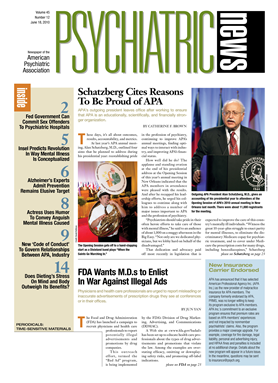Deep in the heart of neuroscience, a worldwide network of researchers is exploring how genetics, imaging, and biochemistry can predict what the mind will do seconds or years in the future (see
Opening a Window on Decision Making).
A few dozen of that band met in a small, but potentially influential conference in Washington, D.C., early in May. The conference was organized by Ilina Singh, Ph.D., a lecturer in bioethics and society at the London School of Economics, and Walter Sinnott-Armstrong, Ph.D., a professor of philosophy at Duke University. It was sponsored by the Wellcome Center for Neuroethics, the Law and Neuroscience Project, the Kenan Institute for Ethics at Duke, and BIOS, an international center for research and policy on social aspects of the life sciences and biomedicine at the London School of Economics.
The complexities of this research and how far it has to go were illustrated by the work of Ahmad Hariri, Ph.D., who has explored the biological pathways and mechanisms of human behavior.
Hariri bases his research on observations of stable traits in humans and then uses a variety of methods to connect brain chemistry, circuitry, and genetics to behavior.
“We probe the underlying brain circuit functions and compare them to well-verified personality measures using functional magnetic resonance imaging [fMRI],” said Hariri, a professor of psychology and neuroscience at the Institute for Genome Sciences and Policy at Duke University.
Variability in brain chemistry drives changes in brain circuitry, and genomic differences drive changes in brain chemistry, he said.
“Changes in trait anxiety are due to underlying brain circuitry. We're limited in using drug challenges to illuminate the dopaminergic and serotonergic signaling systems in humans, but we can do unlimited genetic studies.”
Much of his recent work has concentrated on the amygdala, the tiny part of the brain that is common to all animals with backbones.
That brain region “alerts us to something critical in the environment, usually referred to as ‘fear’ and ‘threat,’ but in reality alerts us to a number of stimuli that may or may not be important.”
Trouble—in the form of maladaptive behavior—happens when that system goes awry. Hariri suggested that the problem is not with amygdala dysfunction but rather with abnormal integration of the amygdala response with the prefrontal cortex.
“Concentrating on a single area of the brain may be less productive than looking at the distributive circuitry across the entire brain to better capture the complexity of information processing,” he said.
Understanding that complexity demands more than one approach.
For example, Hariri placed healthy human volunteers in an fMRI machine and gave them either placebo or tetrahydrocannibinol (THC), the main psychoactive ingredient in marijuana. He then showed them pictures of fearful faces.
The amygdalas of the volunteers given placebo were more activated when shown the faces than were those of subjects given THC. Subjects given THC showed less anxiety and reduced processing of information in the area of the amygdala that contributes to anxiety.
Hariri next explored that same pathway using molecular genetics to model differences in how individuals process an enzyme that limits the activity of THC. A change in just one single-nucleotide polymorphism alters the amino-acid sequence used to create the protein associated with changes in function and in behavior. The A-allele (found in about 25 percent of individuals) reduces expression of the enzyme, resulting in more endogenous cannabinoids and a diminished response to threat by the amygdala.
The A-allele also results in an enhanced reward-related response, compared with the more common C-allele.
A diminished threat response coupled with a higher response to reward is “a deadly combination,” said Hariri. The A-allele is associated with increased impulsivity, illicit drug use, and obesity.
Can such studies predict behavior or psychopathology in individuals? Certainly not yet, said Hariri. The brain, to no one's surprise, is far too complex, and the research is still in a relatively early stage.
For example, his study of four dopaminergic alleles in the ventral striatum accounted for only 13 percent of the variation in response to reward prediction—and there may be dozens of such alleles, he said. Also, brain scans aren't cheap to acquire and require big machines.
Studies so far have been in Caucasian populations, and Hariri cautions against extrapolating conclusions to other races or genetic groups.
“The pieces fit together, but we have yet to test these hypotheses,” he said. The subtle effects of genes on chemistry and vice versa exert equally subtle effects on behavior.
“We need long-term prospective studies with large numbers of subjects testing chemistry, circuitry, and genetics to see if these patterns predict the emergence of psychopathology,” he said.
However, even at this stage, his research has produced some intriguing results, even if they cannot yet be generalized.
Hariri tells of testing a volunteer for genetic markers that reveal response to threat and reward. The middle-aged man scored high on two markers for increased threat response, lower on two other threat markers, and high on three markers for reward response.
“He had the right balance of reward-related drive and a normal sensitivity to threat and danger,” Hariri explained.
The subject was well adapted for the career he had chosen—a writer on the ups and downs of investing. Presumably, said Hariri, a Wall Street trader would have a much lower response to threat.
